Personally, I think that any aquarium is incomplete without plants.
There are lots of benefits of keeping live plants in your aquarium and it also offers you a chance to customize your aquarium to suit your style and make it unique.
But what should you do if you have a sand substrate in your aquarium?
You may have heard that sand is not a very good substrate for planting aquatic plants.
And there is truth to that because there are some plants that are root feeders, which basically means that they get most of the required nutrients from the substrate.
Also, it is a bit difficult for some aquatic plants to get their roots anchored in the sand substrate.
But there is another category of plant that doesn’t get the required nutrients from the substrate but instead gets them from the water column.
Also, if you prepare your sand substrate by adding some root tabs before planting your aquatic plants, it will help them anchor their roots in the sand substrate.
And these are the plants that you can keep and grow in your aquarium with a sand substrate.
In this article, I am going to show you the best aquarium plants that you can use in your sand substrate aquarium.
I have categorized them as
- Low light plants– The plants that can grow in low light.
- No fertilizer plants– The plants that can do well without any fertilizers.
- Easy-to-care for plants- The plants are very easy to care for, which makes them an ideal choice for beginners.
- Others– I have mentioned some other plants you can keep in your sand substrate aquarium.
Table of Contents
21 Best Aquarium Plants for Sand Substrate (Quick Table)
| Plant name | Care level | Placement | Buy from Amazon |
|---|---|---|---|
| Cryptocoryne wendtii | Easy | Midground/Background | Click here |
| Java Fern | Easy | Mid-background | Click here |
| Amazon Sword | Easy | Background | Click here |
| Jungle Vallisneria | Intermediate | Background | Click here |
| Ludwigia repens | Easy | Background | Click here |
| Italian Vallisneria | Intermediate | Background | Click here |
| Anacharis | Easy | Background | Click here |
| Hornwort | Easy | Background | Click here |
| Red tiger lotus | Easy | Mid-ground, background | Click here |
| Java moss | Easy | Foreground | Click here |
| Anubias | Easy | Mid-background | Click here |
| Ludwigia repens | Easy | Background | Click here |
| Subwassertang | Easy | Floating | NA |
| Water wisteria | Easy | Background or Carpet | Click here |
| Temple plant | Easy | Background | Click here |
| Banana plant | Easy | Fore-Mid Ground | Click here |
| Bacopa caroliniana | Easy | Background | Click here |
| Aponogeton Crispus | Easy | 9-10 inches | Click here |
| Giant Hygro | Easy | 24 inches | Click here |
| Green Cabomba | Moderate | 11 inches | Click here |
| Lace plant | Moderate | 20+ inches | Click here |
How to grow live aquarium plants in sand substrate
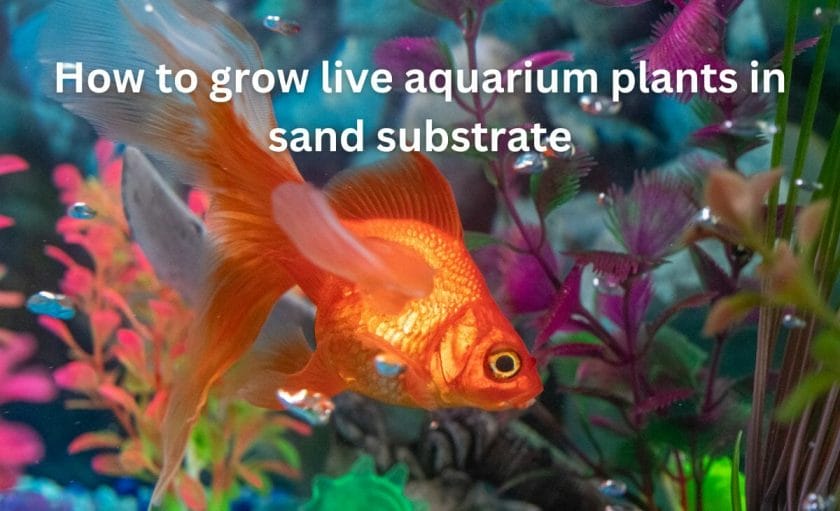
The biggest problem when it comes to growing live aquarium plants in a sand substrate is that sand doesn’t have any nutrients that live aquarium plants need for proper growth and development.
That’s why, to provide nutrients to the plants, especially the ones that absorb a lot of nutrients through their roots, you will need to use or insert root tabs into the substrate.
Root tabs are essentially small capsules that contain nutrients that plants can absorb.
Some people also put nutrient-rich soil at the bottom of the tank and then cap it with a regular sand substrate.
However, I don’t like that because if you have aquarium fish like cichlids that like to borrow the substrate, then the soil can come out and mess up the look of your tank.
That’s why I prefer to use root tabs. They are very convenient to use as well.
You can simply insert the root tabs into the substrate of your aquarium using tweezers or simply with your fingers.
Another thing to keep in mind when it comes to root tabs is that you should also regularly change them.
I like to change it on a monthly basis just to make sure that my aquarium plants are continuously getting the nutrients that they need to grow.
Another solution for the problem that sand substrate doesn’t hold any nutrients for plants is that you can keep live aquarium plants that don’t absorb nutrients through their roots. Instead, they absorb nutrients through their leaves.
There are several such live aquarium plants. And in this category, I really liked the moss plants because they are very hardy and can tolerate a wide range of water parameters, and there are a lot of creative ways to put them in aquariums.
If you just need some greenery in your tank and don’t want to bother with a lot of live plants, then I highly recommend Java moss.
I have given detailed information about this plant later in the article.
Besides that, growing live aquarium plants in a sand substrate is similar to how you would grow live aquarium plants in any substrate.
With that out of the way, let me now tell you the best live aquarium plants for sand substrate.
With that out of the way, let’s dive into the list now…
Best low light aquarium plants for sand substrate
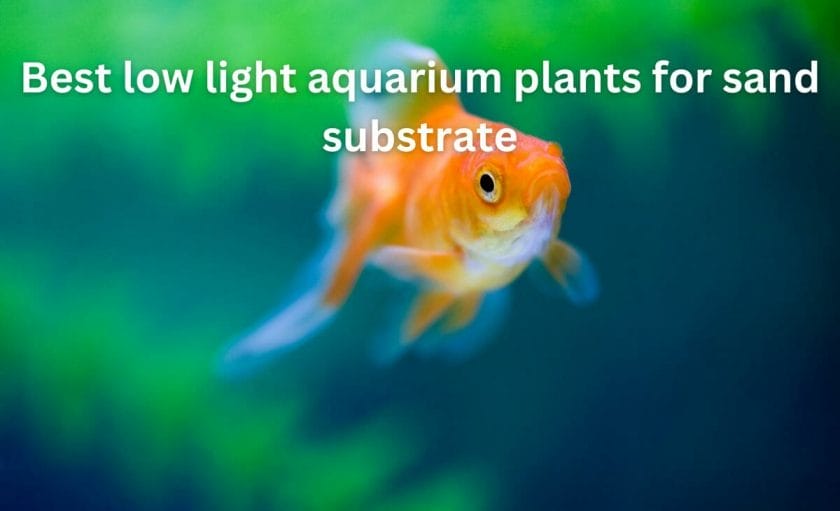
Firstly, we will see the plants that can do well in low lighting conditions.
Some of these plants can do well without fertilizers as well (I’ll get deep into it later in this post, so keep reading)
1.Cryptocoryne wendtii
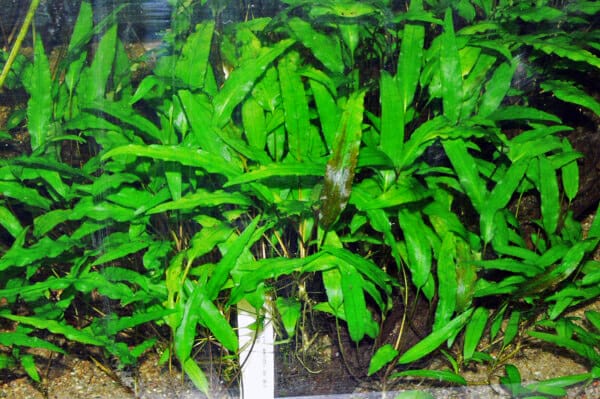
Image by Haplochromis under CC BY 2.5
| PARAMETERS | VALUES |
|---|---|
| PLANT | Cryptocoryne Wendtii |
| COMMON NAMES | Wendt’s Cryptocoryne, water trumpet |
| SCIENTIFIC NAME | Cryptocoryne Wendtii |
| FAMILY | Araceae |
| CARE LEVEL | Easy |
| LIGHT REQUIREMENT | Low |
| GROWTH RATE | Medium |
| TEMPERATURE | 72-82° F |
| pH | 6.0-8.0 |
| HARDNESS | KH 3-8 |
| PLACEMENT | Background |
| MAXIMUM SIZE | 6 inches |
| MINIMUM TANK SIZE | 5 gallon |
Cryptocoryne wendtii is an easy-to-maintain stem plant.
It is good for beginners as well as experienced aquarists.
This plant is also very popular in aquascaping because of its different color and size variations.
This plant comes in red, brown, and green color,s, and its leaf size range from 5 to 18 inch.
How much light does it need?
Cryptocoryne wendtii is undemanding when it comes to light.
It can survive in low light, and it can also tolerate high lighting conditions.
You can use a fluorescent bulb or any LED light bulb for this plant.
What’s the best place to keep it in the aquarium?
As mentioned earlier, Cryptocoryne wendtii comes in different size variations.
You can use this plant in the foreground of a large aquarium.
You can use it as a midground plant in a medium-size aquarium.
The green cryptocoryne wendtii is a smaller variation of this plant.
It grows a maximum of 10-15 centimeters, so you can use it as a background plant for small aquariums.
Ideal water parameters
The ideal temperature for the proper growth of Cryptocoryne wendtii is 72 to 82 degrees Fahrenheit.
The pH tolerance range of this plant is 6-8 and the hardness tolerance range is between 3-8.
Substrate
Cryptocoryne wendtii comes with a solid root system.
Ideally, you should use any gravel or soil substrate for this plant.
But you can also plant this plant in a sand substrate and it will easily get anchored in the sand because of its very good root system.
Fertilization requirements
When you plant Cryptocoryne wendtii in a sand substrate, you should supplement it with some root tabs that are rich in macro and micronutrients as well as rich in iron.
Check the latest price of this plant at Amazon here
Check out My Tips to Take care of Live Plants
2. Java fern
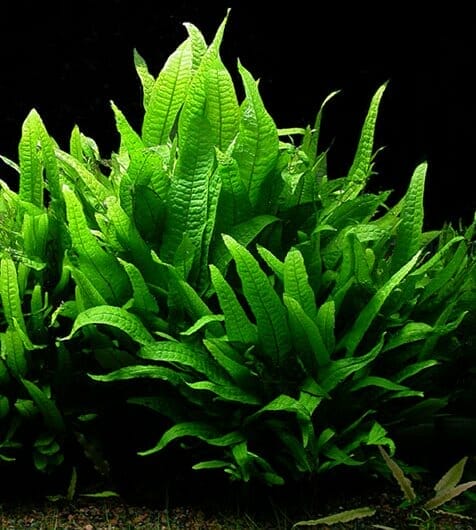
| PARAMETERS | VALUES |
|---|---|
| PLANT | Java Fern |
| COMMON NAMES | Java Fern |
| SCIENTIFIC NAME | Microsorum pteropus |
| FAMILY | Polypodiaceae |
| CARE LEVEL | Easy |
| LIGHT REQUIREMENT | Low to Moderate |
| GROWTH RATE | Low to Moderate |
| TEMPERATURE | 68-82oF |
| pH | 6.0-7.5 |
| HARDNESS | 60-160 ppm |
| PLACEMENT | Mid to Background |
| MAXIMUM SIZE | 13.5 inches |
| MINIMUM TANK SIZE | 5 Gallons |
Java fern is one of the most popular plants in the aquarium hobby.
It is a very hardy plant and can tolerate a wide range of water parameters.
It can tolerate temperatures as low as 68 degrees Fahrenheit so you can use it in a cold water aquarium.
This plant is very easy to care for which makes it ideal for beginners.
How much light does it require?
Java fern doesn’t require a lot of light for its growth.
Low to moderate light is ideal for this plant.
If you keep it under strong lighting then its leaves will turn brown and transparent.
Ideally, you should provide it at least 1.5-2 watts of light per gallon.
What’s the best place to keep it in the tank?
Java fern is not a fast-growing plant, but it can grow very large, so ideally, you should keep it in the middle or in the background of your tank.
Ideal water parameters
Java fern can tolerate a wide range of water parameters.
With that being said, the ideal temperature for the proper growth of Java fern is 68 to 82 degrees Fahrenheit.
The pH tolerance range is from 6 to 7.5.
And the hardness tolerance range is from 3 to 8.
Substrate
Java fern is a water column feeder, so it gets all its nutrients through water.
So, you can use any substrate for this plant.
You can even put it in a bare-bottom tank and it will do well.
So obviously, you can keep it in a sand substrate aquarium.
Java fern comes with rhizomes.
Ideally, you should not bury its rhizomes in the substrate.
Instead, you should tie it to any ornament in your aquarium, which could be driftwood or any rock, and then keep it in your sand substrate aquarium.
Fertilization requirements
Java fern doesn’t really require any fertilizers for its growth.
But if you supplement it with some fertilizers then it will grow faster.
as Java fern is a water column feeder you should add supplements in the form of liquid.
You should add it after a weekly water change.
No Fertilizers Aquarium Plants for Sand Substrate
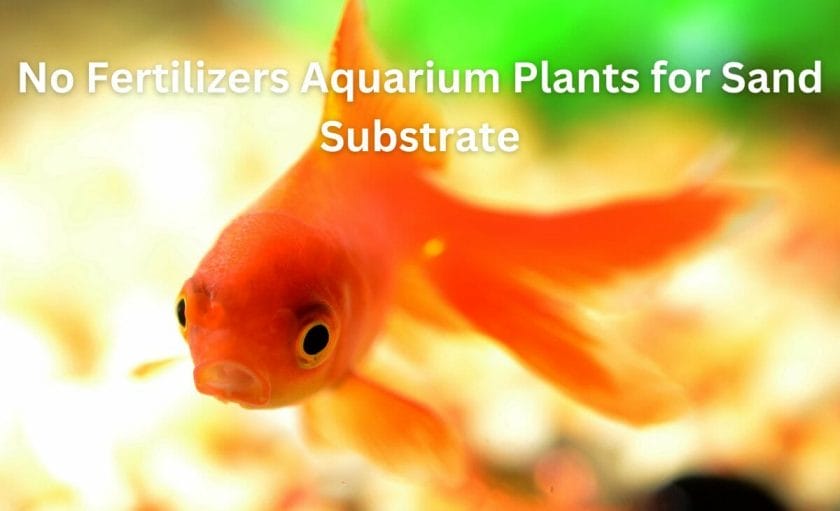
Now we are going to see some aquatic plants that you can keep in your sand substrate that can do well without any fertilizers.
Now like most plants, some plants in this list like Amazon sword, Ludwigia repens, etc. If you supplement them with fertilizers it will certainly increase their growth rate and coloration.
3. Amazon sword
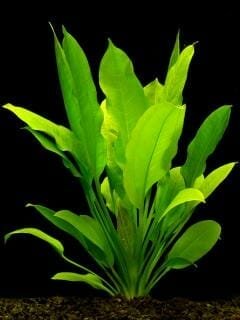
Check the latest price of this plant at Amazon here
| PARAMETERS | VALUES |
|---|---|
| PLANT | Amazon sword |
| SCIENTIFIC NAME | Echinodorus grisebachii |
| FAMILY | Alismataceae |
| CARE LEVEL | Easy |
| LIGHT REQUIREMENT | Moderate |
| GROWTH RATE | Fast |
| TEMPERATURE | 60.8-82.4°F |
| pH | 6.5-7.5 pH |
| HARDNESS | 8-15°dH |
| PLACEMENT | Background |
| MAXIMUM SIZE | 16 Inches |
| MINIMUM TANK SIZE | 10 Gallons |
Amazon sword is one of the most popular aquatic plants in the hobby.
It is a tall aquarium plant that can grow up to 16 inches.
This plant is very hardy and easy to care for, which makes it ideal for beginners.
It can tolerate temperatures as low as 60 degrees Fahrenheit, so you can use it in a cold water aquarium.
How much light does it require?
Amazon sword requires decent lighting for its proper growth.
You should provide it with moderate lighting for at least 11 to 12 hours every day.
You can use any light weather that is fluorescent or LED for this plant.
What’s the best place to keep it in the tank?
Amazon sword grows tall and wide with its long, wide leaves.
So ideally, you should keep it in the mid-ground of your tank if you have a medium-sized aquarium.
You can keep it in the background of your tank if you have a large aquarium.
Substrate
When it comes to the substrate for the Amazon sword, you can use any substrate you want.
It will do well in a sand substrate.
It is actually recommended to use a large-grain sand substrate for this plant.
One thing you should keep in mind when it comes to the substrate for this plant is that the substrate should be at least 2.5 inches thick.
Ideal water parameters
Amazon Sword can tolerate a wide range of water parameters.
With that being said, the ideal temperature for Amazon sword is from 60 to 82 degrees Fahrenheit.
The pH tolerance range is from 6.5 to 7.5.
And the hardness tolerance range is from 8 to 15 degrees DH.
Fertilization requirement
Amazon Sword is a very hardy plant and it can do well without any fertilizers.
It gets nutrients through its roots and from the water as well.
So, if you supplement it with some liquid fertilizers and some root tabs then it will benefit from it though it is not necessary.
Check the latest price of this plant at Amazon here
Plants Help to Lower Temperature in Aquarium
4. Jungle Vallisneria
| PARAMETERS | VALUES |
|---|---|
| PLANT | Jungle Vallisneria |
| COMMON NAMES | Jungle Val, water celery, tape grass or eelgrass |
| SCIENTIFIC NAME | Vallisneria Americana |
| FAMILY | Hydrocharitaceae |
| CARE LEVEL | Intermediate |
| LIGHT REQUIREMENT | Medium |
| GROWTH RATE | Fast |
| TEMPERATURE | 65° – 85° F |
| pH | 6.8 – 8.0 |
| HARDNESS | Moderately Hard to Very Hard |
| PLACEMENT | Background |
| MAXIMUM SIZE | 6 feet (2 meters) |
| MINIMUM TANK SIZE | 10 gallon |
Jungle Vallisneria is one of the few earlier plants that were introduced in the aquarium hobby.
And it is still a favorite of many aquarists.
Jungle Vallisneria is a fast-growing, tall plant that can grow as tall as 6 feet.
It is one of the best oxygenating plants.
It is a pretty hardy plant and can survive in diverse environments.
This plant does require a little bit of care so you should consider it if you have some experience with planted aquariums.
How much light does it require?
Jungle Vallisneria is not very demanding when it comes to light.
It can survive in low lighting, and if you provide it with high light then it will grow faster.
What’s the best place to keep it in the aquarium?
As Jungle Vallisneria can grow very tall, up to 6 feet, you should keep it in the background of your aquarium.
Ideal water parameters
Jungle Vallisneria can tolerate a wide range of water parameters, especially the temperature.
The ideal temperature for the proper growth of Jungle Vallisneria is 65 to 85 degrees Fahrenheit.
The pH tolerance range for this plant is 6.8-8.
And it does well in moderately hard to very hard water.
Substrate
You can use gravel or sand as a substrate for Jungle Vallisneria.
Fertilization requirement
Jungle Vallisneria is a pretty hardy plant and can do well without any fertilizers.
But if you provide it with some iron-rich fertilizers in the form of liquid, then it can help to better nourish it.
You should add this fertilizer after the weekly water change.
Check the latest price of this plant at Amazon here
5. Ludwigia repens
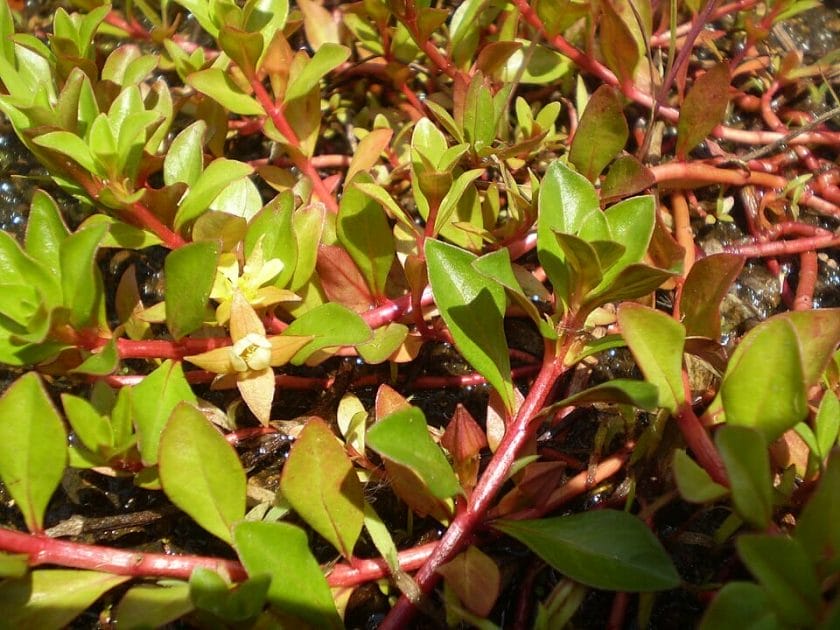
| PARAMETERS | VALUES |
|---|---|
| PLANT | Ludwigia Repens |
| COMMON NAMES | Ludwigia repens, Ludwigia repens Rubin, Red repens, Ludwigia sp. Weinrot, Red-Leaf Ludwigia, Creeping Primrose-Willow |
| SCIENTIFIC NAME | Ludwigia repens |
| FAMILY | Onagraceae |
| CARE LEVEL | Easy |
| LIGHT REQUIREMENT | Low to very high |
| GROWTH RATE | Moderate to Fast |
| TEMPERATURE | 60- 86oF |
| pH | 5 – 8 |
| HARDNESS | Very soft to hard level |
| PLACEMENT | Background |
| MAXIMUM SIZE | 7-19 inches |
| MINIMUM TANK SIZE | 10 gallon |
Ludwigia repens is a very popular coloring plant in aquascaping.
The color of this plant ranges from deep green to deep red.
It is a tall, stem plant that can grow up to 19 inches.
This plant can tolerate temperatures as low as 60 degrees Fahrenheit, so you can keep it in a cold water aquarium.
This plant is very easy to care for which makes it ideal for beginners.
How much light does it require?
Ludwigia repens requires moderate to high light.
You should provide it with at least 2 watts per gallon of your aquarium.
For faster growth and red coloration, you should provide it with 4 watts per gallon of your aquarium.
You can use any fluorescent or LED light for this plant.
What’s the best place to keep it in the aquarium?
Ludwigia repens is a tall stem plant that can grow up to 19 inches.
So, you should put it in the background of your aquarium.
Ideal water parameters
Ludwigia repens can tolerate a wide range of water parameters.
The ideal temperature for the proper growth of Ludwigia repens is 62–86 degrees Fahrenheit.
The pH tolerance range is from 5 to 8.
And you can use very soft to very hard water for this plant.
Substrate
You can use any substitute for Ludwigia repens.
You can plant it in a sand substrate as well.
When you keep it in a sand substrate, there is a danger that its roots might suffocate.
But there are a lot of people who have successfully kept them in sand substrate aquariums.
Fertilization requirements
Ludwigia repens is a very hardy plant, and it doesn’t need any fertilizers for its growth.
With that being said, you can always supplement it with additional CO2 to speed up its growth and improve its coloration.
One study shows that CO2 affects the growth and leaf size of Ludwigia Repens.
Check the latest price of this plant at Amazon here
6. Italian Vallisneria
| PARAMETERS | VALUES |
|---|---|
| PLANT | Italian Vallisneria |
| COMMON NAMES | Italian Vallisneria |
| SCIENTIFIC NAME | Vallisneria spiralis |
| FAMILY | Hydrocharitaceae |
| CARE LEVEL | Easy |
| LIGHT REQUIREMENT | Moderate |
| GROWTH RATE | Moderate to Fast |
| TEMPERATURE | 72-80℉ |
| pH | 6.0-7.5 |
| HARDNESS | 4 – 18°N |
| PLACEMENT | Background |
| MAXIMUM SIZE | 11.81 – 21.65 inch |
| MINIMUM TANK SIZE | 10 gallon |
Italian Vallisneria is a very hardy and easy-to-maintain plant which makes it ideal for beginners.
This plant is very cheap, and it propagates very fast, so you don’t need a lot of it.
How much light does it require?
Italian Vallisneria can do well in moderate light of at least 2 watts per gallon.
But if you provide more than that, it will grow faster.
What’s the best place to keep it in the tank?
Italian Vallisneria is a tall plant that can grow up to 21 inches, which makes it a very good background plant.
Ideal water parameters
The ideal temperature for the proper growth of Italian Vallisneria is between 72 to 80 degrees Fahrenheit.
The pH tolerance range is from 6 to 7.5
And the hardness tolerance range is from 4 to 18° N.
Substrate
You can use any substrate (even sand) for planting Italian Vallisneria in your aquarium.
It propagates very fast, and you will see a lot of runners in very little time.
Fertilization requirement
Italian Vallisneria doesn’t really need any fertilizers for its growth.
But for faster growth, you can supplement it with some fertilizers.
Italian Vallisneria can get nutrients through its roots so you should add fertilizers in the form of root fertilizers.
Easy live aquarium plants for sand substrate
Now we’ll see easy to care for live aquarium plants that you can plant in sand substrate.
As these are very easy-to-care for plants, if you are a beginner with live plants, you should start with these plants.
7. Anacharis
See more images at Amazon here
| PARAMETERS | VALUES |
|---|---|
| PLANT | Anacharis |
| SCIENTIFIC NAME | Elodea |
| FAMILY | Hydrocharitaceae |
| CARE LEVEL | Easy |
| LIGHT REQUIREMENT | Moderate |
| GROWTH RATE | Fast |
| TEMPERATURE | 60-82° F |
| pH | 6.5-7.5 |
| HARDNESS | KH 3-8 |
| PLACEMENT | Background |
| MAXIMUM SIZE | 6 to 8 inches |
| MINIMUM TANK SIZE | 10 gallon |
Anacharis is one of the most popular plants in the aquarium hobby.
If you are looking for a tall-growing, stem plant that is very easy to care for, then this aquarium plant is for you.
This plant can tolerate a wide range of water parameters, and you can also keep it in a cold water tank as well.
How much light does it need?
Anacharis does well under moderate lighting conditions.
So you should provide at least two watts of light per gallon of your aquarium.
If you provide it with too much light, then this can result in algae growth on it.
On the other hand, if you provide it with less light, then it will die.
What’s the best place to keep it in an aquarium?
As Anacharis is a tall growing stem plant, depending on the size of your aquarium you should keep it in the middle ground or background of your tank.
Ideal water parameters
As mentioned earlier, Anacharis can tolerate a wide range of water parameters, especially temperature.
It can tolerate temperatures as low as 60 degrees Fahrenheit to up to 82 degrees Fahrenheit, which makes it an ideal choice for not only a cold water aquarium but also for a tropical aquarium.
Besides, its pH tolerance range is between 6.5 to 7.5, and its water hardness tolerance range is between 3-8 KH.
Substrate requirements
Anacharis is very hardy, and you can plant it in sand substrate.
Fertilization requirements
If you are planting Anacharis in a cold water aquarium, you don’t need to provide it with any additional fertilizers.
However, if you are planting it in a tropical aquarium, then you should supplement it with fertilizers that are specifically rich in CO2.
8. Hornwort
Hornwort is another aquarium plant that is extremely popular among hobbyists.
And the reason behind that is that it is very hardy and can tolerate a wide range of water parameters.
Besides, it is also very beginner-friendly.
How much light does it need?
Hornwort prefers moderate to high lighting conditions.
Under high lighting conditions, it will grow much faster.
What’s the best place to keep it in an aquarium?
Hornwort can grow pretty tall, as tall as 10 feet. So you should plant it in the background of your aquarium.
Ideal water parameters
As mentioned earlier, Hornwort can tolerate a wide range of water parameters.
This plant can tolerate temperatures as low as 59 degrees Fahrenheit up to 86 degrees Fahrenheit.
Its pH tolerance range is between 6 to 7.5, and its water hardness tolerance range is between 5 to 15 dGH.
Substrate requirements
The best part about Hornwort is that it actually doesn’t have any real roots, so it doesn’t draw any nutrients from the substrate.
Which makes it a very good choice to plant in a sand substrate.
You can simply use its leaves to anchor it into the sand substrate.
Fertilization requirements
Hornwort possesses allelopathic abilities, which basically means that it can release certain chemicals that prevent other plants in its environment from taking nutrients for themselves so that this plant can take all the nutrients for itself.
So usually, you don’t need to provide any additional fertilizers to Hornwort.
However, if you are keeping other plants along with this plant, then you should add fertilizer in your tank just to make sure that all the plants in your aquarium are getting the nutrients.
9. Red tiger lotus
If you are looking for a red aquarium plant that also produces flowers, then Red tiger lotus is for you.
How much light does it need?
Light is usually not an issue for Red tiger lotus.
However, under low lighting conditions, you may notice that it will lose its compact growth.
So if you see that it’s losing its compact growth, then you should increase lighting.
What’s the best place to keep it in an aquarium?
Red tiger lotus is a tall growing aquarium plant that can grow as tall as 31 inches, so you should keep it in the background of your aquarium.
Ideal water parameters
The ideal temperature range for Red tiger lotus is between 71 to 82 degrees Fahrenheit.
So this is a very good plant to keep in a tropical aquarium.
Substrate requirements
You can plant Red tiger lotus in a sand substrate. Just make sure to provide it with a lot of nutrients through root tabs.
Fertilization requirements
For optimum growth and to maintain its red coloration, Red tiger lotus needs a lot of nutrients.
As you are going to plant it in a sand substrate, make sure to provide it with a lot of nutrients through root tabs.
10. Java moss
If you are looking for a cheap and popular aquarium plant, then Java moss is for you.
This aquarium plant is extremely easy to care for, which makes it an ideal choice for beginners.
How much light does it need?
Light is not an issue for Java moss.
It will survive in low to high lighting conditions.
However, you will notice some difference in its growth depending on how much light it is getting.
Under high lighting conditions, it will grow much more compact and dense.
On the other hand, under low lighting conditions, it will grow much lankier.
What’s the best place to keep it in an aquarium?
There are a lot of creative ways you can put Java moss in your aquarium.
You can spread it across the substrate of your aquarium and use it as a carpet plant.
Or a more common way is to attach it to something like driftwood or rock and then put it inside your aquarium.
Ideal water parameters
The ideal temperature range for Java moss is between 59 to 86 degrees Fahrenheit.
So you can keep it in a cold water aquarium as well as a tropical aquarium.
It’s pH tolerance range is between 5 to 8 and it prefers soft water.
Substrate requirements
As Java moss doesn’t draw nutrients from the substrate, it is a great plant to plant on a sand substrate.
You can just spread it across your sand substrate and use it as a carpet plant.
Fertilization requirements
Java moss is very undemanding, so it can do just fine without any additional fertilizers.
11. Anubias
See more images at Amazon here
Anubias is one of the most popular plants in the aquarium hobby.
It is very hardy which makes it an ideal choice for beginners.
How much light does it need?
Anubias does well under low to moderate lighting conditions.
So you should provide it with light anywhere between 2 to 3 Watts per gallon of your aquarium.
What’s the best place to keep it in an aquarium?
As Anubias is a short plant, you should keep it in the foreground or middle ground of your aquarium.
Ideal water parameters
The ideal temperature range for Anubias is between 72 to 82 degrees Fahrenheit.
So it is a very good plant to keep in a tropical aquarium.
Its pH tolerance range is between 6.5 to 7.8, and its water hardness tolerance range is between 3 to 8 KH.
Substate requirements
Anubias doesn’t draw a lot of nutrients through the substrate, which makes it an ideal choice to plant in a sand substrate.
Besides, you can also plant it in a gravel substrate, and you can also attach it to any ornaments in your tank, like driftwood or porous rocks.
Fertilization requirements
For optimum and healthy growth, you should regularly supplement Anubias with liquid fertilizers.
12. Ludwigia repens
See more images at Amazon here
| PARAMETERS | VALUES |
|---|---|
| PLANT | Ludwigia Repens |
| COMMON NAMES | Ludwigia repens, Ludwigia repens Rubin, Red repens, Ludwigia sp. Weinrot, Red-Leaf Ludwigia, Creeping Primrose-Willow |
| SCIENTIFIC NAME | Ludwigia repens |
| FAMILY | Onagraceae |
| CARE LEVEL | Easy |
| LIGHT REQUIREMENT | Low to very high |
| GROWTH RATE | Moderate to Fast |
| TEMPERATURE | 60- 86oF |
| pH | 5 – 8 |
| HARDNESS | Very soft to hard level |
| PLACEMENT | Background |
| MAXIMUM SIZE | 7-19 inches |
| MINIMUM TANK SIZE | 10 gallon |
If you are looking for an aquarium plant that can tolerate a wide range of water parameters and comes in different colors, then Ludwigia repens is for you.
How much light does it require?
Ludwigia repens does well under moderate to highlighting conditions.
So you should provide it with light anywhere between two to four watts per gallon of your aquarium.
What’s the best place to keep it in an aquarium?
Ludwigia repens can grow pretty tall, up to 19 inches, so you should keep it in the background of your aquarium.
Ideal water parameters
As mentioned earlier, Ludwigia repens can tolerate a wide range of water parameters.
It can tolerate temperatures as low as 60 degrees Fahrenheit up to 86 degrees Fahrenheit.
So you can keep it in a cold water aquarium as well as in a tropical aquarium.
Besides, it’s pH tolerance range is between 5 to 8. And you can keep it in soft water as well as hard water.
Substrate requirements
You can plant Ludwigia repens in sand substrate. Ideally, you should use organic volcanic sand substrate for this plant.
Fertilization requirements
For optimum growth and coloration, you should supplement Ludwigia repens with fertilizers on a regular basis.
However, it can do just fine without it.
13. Subwassertang
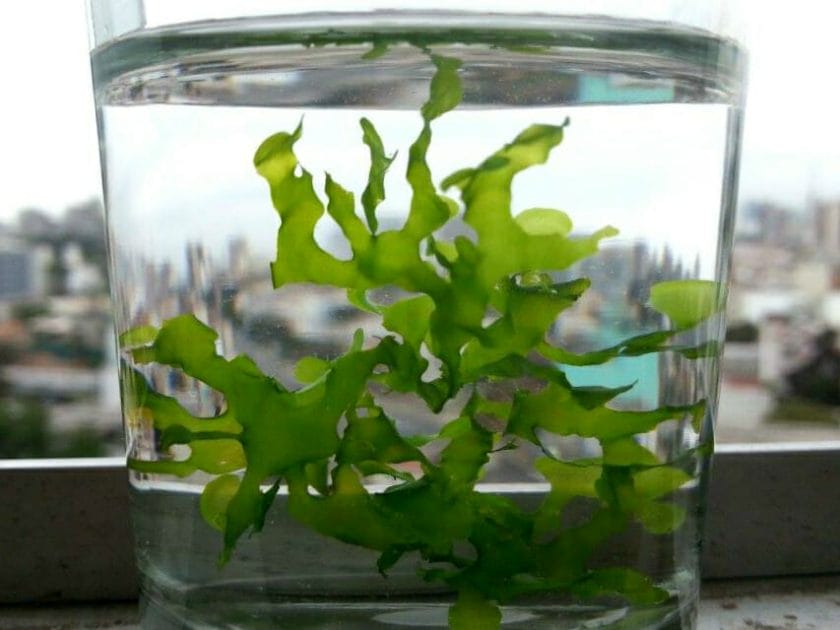
Photo by Rǫgn under CC BY-SA 4.0
| PARAMETERS | VALUES |
|---|---|
| PLANT | Subwassertang |
| COMMON NAMES | Süsswassertang, Süßwassertang, Round Pellia, False Round Pellia |
| SCIENTIFIC NAME | Süsswassertang |
| FAMILY | Lomariopsidaceae |
| CARE LEVEL | Easy |
| LIGHT REQUIREMENT | Low to moderate |
| GROWTH RATE | Slow |
| TEMPERATURE | 68-73° F |
| pH | 6-8 |
| HARDNESS | 0 – 21°dKH |
| PLACEMENT | Floating |
| MINIMUM TANK SIZE | 5 gallon |
If you are looking for a plant that grows very densely and can provide a lot of hiding places in your tank, then Subwassertang is for you.
How much light does it need?
Subwassertang does well under low to moderate lighting conditions.
So you should provide around two watts of light per gallon of your aquarium.
What’s the best place to keep it in an aquarium?
The most common way of keeping Subwassertang in an aquarium is to just let it float in the aquarium, and eventually it will attach itself to something.
You can also tie it to something in your tank using a thread.
Ideal water parameters
The ideal temperature range for Subwassertang is between 68 to 73 degrees Fahrenheit.
It’s pH tolerance range is between 6 to 8 and it prefers soft water.
Substrate requirements
You don’t need any substrate to keep Subwassertang in your aquarium.
Usually, you just need to keep it free floating in your aquarium, and eventually it will get attached to something in your tank.
Fertilization requirements
Subwassertang can do well without any additional fertilizers.
However, it will definitely benefit if you can provide it with some liquid fertilizer.
14. Water wisteria
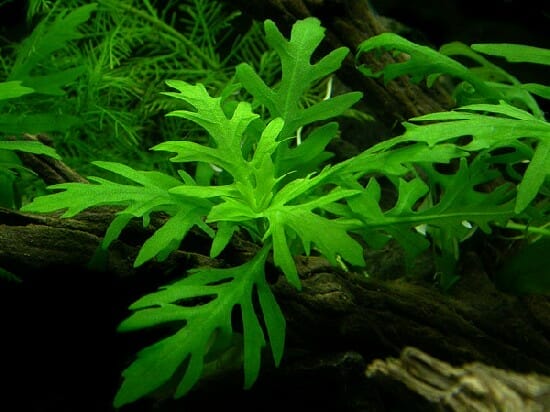
| PARAMETERS | VALUES |
|---|---|
| PLANT | Water wisteria |
| SCIENTIFIC NAME | Hygrophila difformis |
| FAMILY | Acanthaceae |
| CARE LEVEL | Easy |
| LIGHT REQUIREMENT | Moderate to High |
| GROWTH RATE | Fast |
| TEMPERATURE | 70-82°F |
| pH | 6.5-7.5 |
| HARDNESS | 2-8 KH |
| PLACEMENT | Background or Carpet |
| MAXIMUM SIZE | 20 inches |
| MINIMUM TANK SIZE | 10 gallons |
Water wisteria is very hardy and can tolerate a wide range of water parameters, which makes it an ideal choice for beginners.
How much light does it need?
Water wisteria does well under moderate lighting conditions.
So you should provide it with light anywhere between 2 to 3 Watts per gallon of your aquarium.
What’s the best place to keep it in an aquarium?
Water wisteria can grow pretty tall up to 20 inches, so if you plant it in your substrate, then you should plant it in the background of your tank.
Besides, you can also spread it across your substrate and use it as a carpet plant.
Ideal water parameters
The ideal temperature range for Water wisteria is between 70-82 degrees Fahrenheit.
Its pH tolerance range is between 6.5 to 7.5, and its water hardness tolerance range is between 2 to 8 KH.
Substrate requirements
In its natural habitat, Water wisteria grows in a sandy substrate, which makes it an excellent choice to plant in a sand substrate.
Fertilization requirements
Water wisteria is very undemanding, so it can do just fine without any additional fertilizers.
However, if you provide it with fertilizer regularly, it will definitely benefit from it.
15. Temple plant
See more images at Amazon here
| PARAMETERS | VALUES |
|---|---|
| PLANT | Giant Hygro |
| SCIENTIFIC NAME | Hygrophila corymbosa |
| FAMILY | Acanthaceae |
| CARE LEVEL | Easy |
| LIGHT REQUIREMENT | Medium |
| GROWTH RATE | Fast |
| TEMPERATURE | 72-84° F |
| pH | 6.0-7.5 |
| HARDNESS | 71.43 – 321.43 PPM |
| PLACEMENT | Background |
| MAXIMUM SIZE | 24 inches |
| MINIMUM TANK SIZE | 10 Gallons |
Temple plant is very hardy and can tolerate a wide range of water parameters, which makes it an ideal choice for beginners.
How much light does it need?
Temple plant does well under moderate lighting conditions.
So you should provide it with light anywhere between 2 to 3 Watts per gallon of your aquarium.
What’s the best place to keep it in an aquarium?
Temple plant can grow pretty tall, up to 24 inches, so you should keep them in the background of your tank.
Ideal water parameters
The ideal temperature range for this plant is between 72 to 84 degrees Fahrenheit, which makes it a great choice for a tropical aquarium.
Its pH tolerance range is between 6 to 7.5, and its water hardness tolerance range is between 3-8 KH.
Substrate requirements
You can plant Temple plant in a sand substrate.
To plant it, just lay it on your substrate, and the stem of the plant will start to grow roots into the substrate.
You can also bury its tips into the sand substrate to plant it.
Fertilization requirements
For optimum growth and development, you should regularly supplement this plant with fertilizers that are rich in iron, potassium, and other trace elements.
16. Banana plant
See more images at Amazon here
| PARAMETERS | VALUES |
|---|---|
| PLANT | Banana Plant |
| COMMON NAMES | Banana Plant |
| SCIENTIFIC NAME | Musa |
| FAMILY | Menyanthaceae |
| CARE LEVEL | Easy |
| LIGHT REQUIREMENT | Low |
| GROWTH RATE | Moderate |
| TEMPERATURE | 68 – 82°F |
| pH | 6.0 – 7.5 |
| HARDNESS | KH 3-6 |
| PLACEMENT | Fore-Mid Ground |
| MAXIMUM SIZE | 6 inches |
| PROPAGATION | Adventitious |
If you are looking for a short, easy-to-care-for plant, then Banana plant is for you.
How much light does it need?
Banana plant is very hardy and can survive in any lighting condition, whether that is low to high.
What’s the best place to keep it in an aquarium?
As Banana plant is a short aquarium plant that can grow to a maximum of 6 inches, you should keep it in the foreground or middle ground of your aquarium.
Ideal water parameters
The ideal temperature range for Banana plant is between 68 to 82 degrees Fahrenheit.
Its pH tolerance range is between 6 to 7.5, and its water hardness tolerance range is between 3-6 KH.
Substrate requirements
You can plant Banana plant in sand substrate; just make sure that the substrate is at least 2 inches thick.
Fertilization requirements
Banana plant is very undemanding and can do well without any additional fertilizers.
However, you should regularly supplement it with all-in-one liquid fertilizer and root tabs for optimum growth.
17. Bacopa caroliniana
See more images at Amazon here
| PARAMETERS | VALUES |
|---|---|
| PLANT | Bacopa |
| SCIENTIFIC NAME | Bacopa Caroliniana |
| FAMILY | Scrophulariaceae |
| CARE LEVEL | Easy |
| LIGHT REQUIREMENT | Low |
| GROWTH RATE | Slow |
| TEMPERATURE | 69.8 – 80.6°F |
| pH | 6.8 – 7.2 |
| HARDNESS | 71.43 – 142.86 PPM |
| PLACEMENT | Background |
| MAXIMUM SIZE | 11+ inches |
| MINIMUM TANK SIZE | 10 gallons |
If you are looking for a tall growing, stem plant that is beginner-friendly as well, then Bacopa caroliniana is for you.
How much light does it need?
Bacopa caroliniana is very hardy and can survive in any lighting condition.
What’s the best place to keep it in an aquarium?
Bacopa caroliniana can grow up to 11 inches, so depending on the size of your aquarium, you should keep it in the middle ground or background of your tank.
Ideal water parameters.
The ideal temperature range for Bacopa caroliniana is between 69 to 80 degrees Fahrenheit, which makes it an ideal choice for cold water aquariums as well as tropical aquariums.
Besides, its pH tolerance range is between 6.8 to 7.2, and its water hardness tolerance range is between 4 to 8 degrees N.
Substrate requirements
You can plant Bacopa caroliniana in a sand substrate.
And you can directly plant or bury the roots of the plant into the sand substrate to plant it in the substrate.
Fertilization requirements
This aquarium plant is very hardy and can do well without any additional fertilizers.
However, it will obviously benefit if you can provide it with some fertilizer.
Other plants
Now we will see some other plants that you can keep in a sand substrate aquarium.
These plants will require decent light or fertilizer for their growth.
Provided with that, they can easily survive and grow in a sand substrate.
Plants help to Lower Ammonia Levels in Your Aquarium
18. Aponogeton Crispus
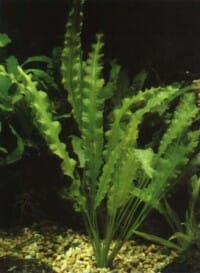
| PARAMETERS | VALUES |
|---|---|
| PLANT | Aponogeton Crispus |
| SCIENTIFIC NAME | Aponogeton Crispus |
| FAMILY | Aponogetonaceae |
| CARE LEVEL | Easy |
| LIGHT REQUIREMENT | Moderate |
| GROWTH RATE | Fast |
| TEMPERATURE | 64-86° F |
| pH | below 7.5 |
| PLACEMENT | Background |
| MAXIMUM SIZE | 9-10 inches |
| MINIMUM TANK SIZE | 20 gallon |
Aponogeton Crispus is a very easy-to-maintain plant, but it does require a lot of nutrients for its proper growth.
It is a fast-growing plant that can grow up to 10 inches.
You can keep it in a cold water aquarium because it can survive in temperatures as low as 64 degrees Fahrenheit.
How much light does it require?
Aponogeton Crispus is not very light-demanding.
But you should provide at least 0.5 watts of light per liter.
What’s the best place to keep it in the tank?
Aponogeton Crispus is a tall plant that can grow up to 10 inches so people usually keep it in the background of their tanks.
Ideal water parameters
As mentioned earlier, this plant can tolerate a wide range of water parameters, especially the temperature.
That being said, the ideal temperature for the proper growth of Aponogeton Crispus ranges from 64 to 86 degrees Fahrenheit.
The pH of the water should be below 7.5.
Substrate
As mentioned earlier, Aponogeton Crispus requires a good amount of nutrients for its proper growth.
Ideally, you should plant it in a nutrient-rich substrate, but there are some people who have successfully kept it in a sand substrate.
This plant doesn’t have real roots; instead, it has rhizomes that are 2-3 cm long and up to 5 cm in diameter.
You can bury these rhizomes in the sand substrate.
Fertilization requirements
Aponogeton Crispus requires a good amount of nutrients for its proper growth.
And when you keep it in a sand substrate, you should definitely supplement it with root tabs so that it can get sufficient nutrients and its roots can get anchored in the substrate properly.
Besides, you should also supplement it with liquid fertilizers, especially after the weekly water change.
19. Giant Hygro
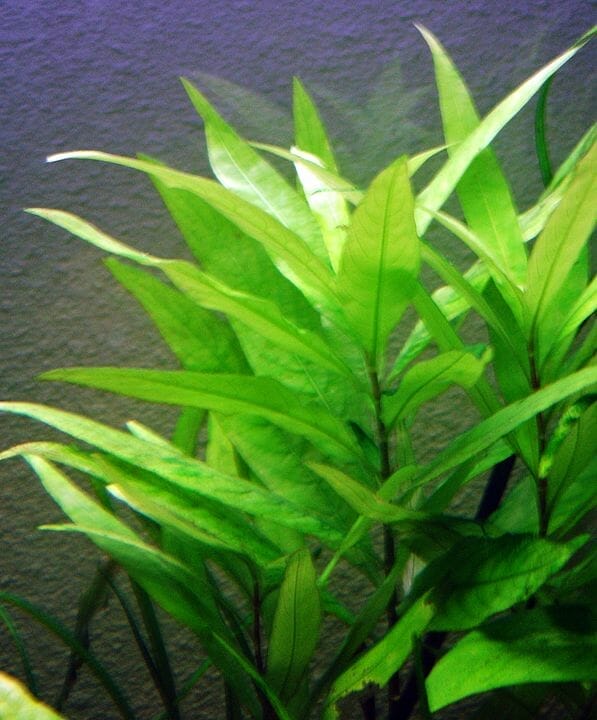
| PARAMETERS | VALUES |
|---|---|
| PLANT | Giant Hygro |
| SCIENTIFIC NAME | Hygrophila corymbosa |
| FAMILY | Acanthaceae |
| CARE LEVEL | Easy |
| LIGHT REQUIREMENT | Medium |
| GROWTH RATE | Fast |
| TEMPERATURE | 72-84° F |
| pH | 6.0-7.5 |
| HARDNESS | 71.43 – 321.43 PPM |
| PLACEMENT | Background |
| MAXIMUM SIZE | 24 inches |
| MINIMUM TANK SIZE | 10 Gallons |
Giant Hygro is commonly known as Temple plant.
It is a very hardy plant and can tolerate a wide range of water parameters, which makes it ideal for beginners.
How much light does it require?
Giant Hygro does well when you provide it with moderate light.
Ideally, you should provide it at least 2 to 3 watts per gallon of light.
What’s the best place to keep it in the tank?
If you have a medium-sized aquarium, then you should keep it in the background of the tank.
if you have a large aquarium, you can keep it in the middle ground of the tank.
Ideal water parameters
The ideal temperature for the proper growth of Giant Hygro is from 72 to 84 degrees Fahrenheit.
The pH tolerance range is from 6 to 7.5.
And the hardness tolerance range is from 3 to 8 KH.
Substrate
You can use gravel or sand substrate for planting this plant in your aquarium.
Planting this plant is very easy; you just have to lay it on the substrate, and its stem will start producing roots that will get into the substrate.
Fertilization requirements
You should supplement Giant Hygro with regular dozing of fertilizers.
You should use nutrient-rich root tabs as well as some liquid fertilizer for this plant.
Check the latest price of this plant at Amazon here
Check out my Tips to Maintain a Healthy Aquarium
20. Green Cabomba
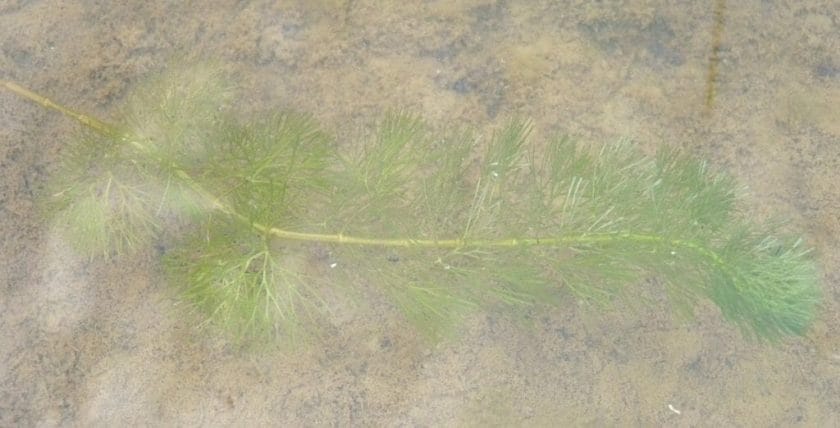
Image by Show ryu under CC BY-SA 3.0
| PARAMETERS | VALUES |
|---|---|
| PLANT | Green Cabomba |
| COMMON NAMES | Green Cabomba, Carolina Fanwort, Brazilian Fanwort, Fanwort |
| SCIENTIFIC NAME | Cabomba caroliniana |
| FAMILY | Cabombaceae |
| CARE LEVEL | Moderate |
| LIGHT REQUIREMENT | Medium to High |
| GROWTH RATE | Fast |
| TEMPERATURE | 72 – 82 ℉ |
| pH | 6.8 – 7.5 |
| HARDNESS | KH 3-8 |
| PLACEMENT | Background or Floating |
| MAXIMUM SIZE | 11 inches |
| MINIMUM TANK SIZE | 10 gallon |
If you are looking for a fast growing plant that produces attractive flowers in an aquarium, then Green Cabomba is for you.
How much light does it need?
Green Cabomba does well under moderate to high lighting conditions.
Ideally, you should provide at least three watts of light per gallon of your aquarium.
What’s the best place to keep it in an aquarium?
As Green Cabomba can grow tall, you should keep it in the middle or background of your tank.
Besides, you can also keep it floating in your aquarium.
Ideal water parameters
The ideal temperature range for Green Cabomba is between 72 to 82 degrees Fahrenheit, which makes it an ideal choice to keep in a tropical aquarium.
Its pH tolerance range is between 6.8 to 7.5, and its water hardness tolerance range is between 3 to 8 KH.
Substrate requirements
Green Cabomba doesn’t draw a lot of nutrients through the substrate, which makes it an ideal choice to plant in a sand substrate.
Besides, you can also keep it floating in an aquarium.
Fertilization requirements
For optimum growth and development, you should regularly supplement Green Cabomba with liquid fertilizers and root tabs.
21. Lace plant
If you are looking for an aquarium plant with a unique leaf structure that also flowers in aquariums, then Lace plant is for you.
How much light does it need?
Lace plant does well under moderate to highlighting conditions.
So you should provide it with light anywhere between 3-5 Watts per gallon of your aquarium.
What’s the best place to keep it in an aquarium?
Lace plant can grow pretty tall, so you should keep it in the middle ground of your aquarium.
Ideal water parameters
The ideal temperature range for Lace plant is between 72 to 82 degrees Fahrenheit.
Its pH tolerance range is between 6 to 7 and its water hardness tolerance range is between 3 to 6 KH.
Substrate requirements
You can plant Lace plant in a sand substrate.
For planting it in the sand substrate, just bury half of its bulb into the substrate and keep half of the bulb above the substrate.
Fertilization requirements
For optimum growth, you should regularly supplement Lace plant with liquid fertilizers as well as root tabs that are rich in iron, CO2, and other trace elements.
How to choose live aquarium plants for sand substrate
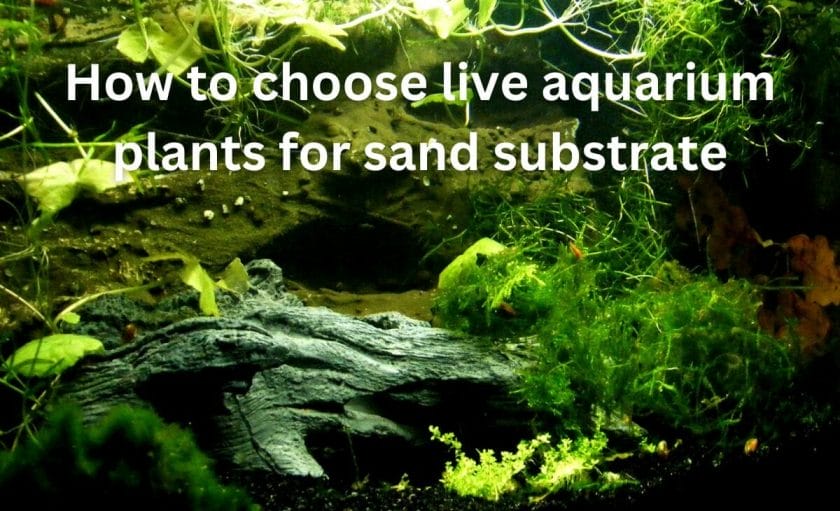
Now I will share with you some tips that will help you choose live aquarium plants for sand substrate.
Choose healthy plants
When you are shopping for live plants, you should make sure that the plants you are choosing are lush green in color and don’t have any dead leaves.
Choose undemanding plants
This point is very important, especially if you are a beginner and just starting out with live aquarium plants.
You should always go for very undemanding and easy-to-care-for plants if you are a beginner.
Choose live plants according to the size of your tank
When you are shopping for live aquarium plants, before choosing the plant, do some research and find out what the maximum height it can grow to. And then you should decide whether your fish tank is actually compatible with that plant or not.
Besides, you should also have some idea about what kind of aquascape you want to create in your tank and choose the plants accordingly.
For example, if you want to create a jungle effect in your tank, you should ideally choose plants that grow leaves in all directions and have larger leaves.
If you are going for a Jungle effect, then I highly recommend you get an Amazon sword, and you should plant this plant in the center of your tank.
Besides, if you are going for a carpeting effect, then you should choose plants such as Java moss.
How to set up a planted tank with sand substrate
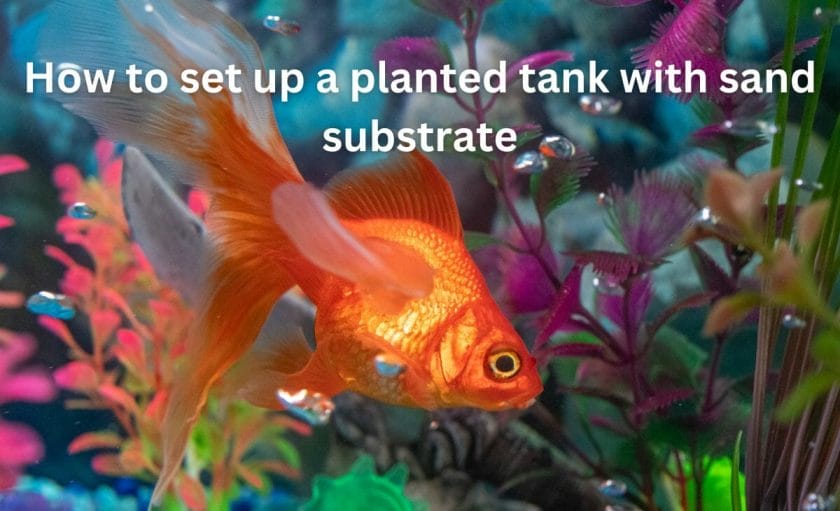
Now I will share with you the process of setting up a planted tank with sand substrate.
Clean the sand
First of all, you will need to wash the sand twice to three times before adding it to the tank.
This process is extremely important to remove any dust from the sand.
If you don’t do this step, then once you add the sand to the tank and pour down water, your fish tank will look cloudy.
Add the sand
After cleaning the sand, just place the sand at the bottom of your fish tank.
Pour water into the tank
Now, before pouring water into the tank, first of all, you should put something like a plastic bag or a small bucket into the tank, and then you should slowly pour water into the tank.
This way, the sand will not get disturbed due to water flow.
Plant the live aquarium plants
Now you should properly plant the live aquarium plants into the sand substrate with the help of tweezers.
Add root tabs
Now you should insert root tabs near the roots of the live aquarium plants to provide them with all the nutrients that they need to grow and thrive in your tank.
Set up all the other equipment
At this point, you should set up all the other equipment, like the aquarium filter, aquarium heater, aquarium light, etc.
Cycle your fish tank
At this point, you should cycle your fish tank before adding fish to it.
There are different ways to cycle a fish tank.
What type of sand is best for a planted aquarium?
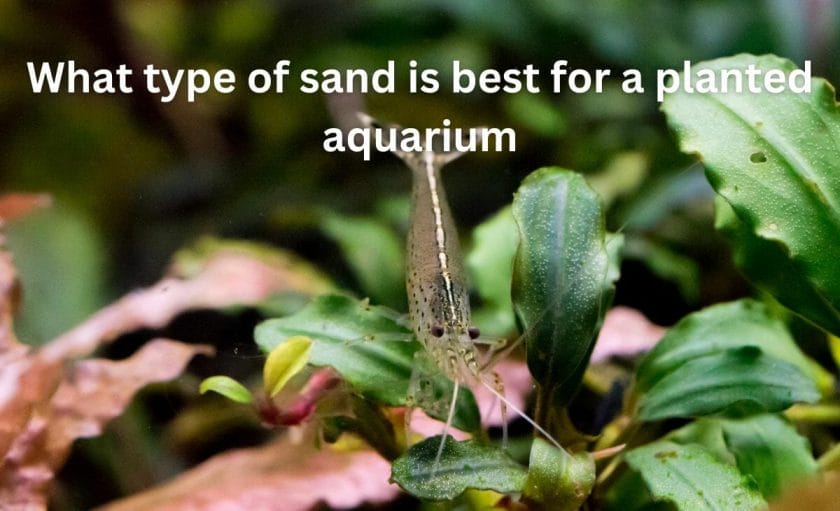
When it comes to sand for your planted aquarium, you have a couple of options.
The first option is to use just regular sand, which you can easily find at your local fish store or online.
The other option is to use sand that is specifically made for planted aquariums.
I recommend fluoride black sand from Seachem.
Now, when it comes to the best sand possible for a planted tank, the second option is obviously the best because it contains nutrients that plants need for their proper growth and development, so they will grow much better if you plant them in such sand.
Pros and cons of using sand substrate for a planted aquarium
Sand substrate is not perfect, and it has some benefits and drawbacks, which I am going to cover now.
Pros of using sand substrate for planted aquarium
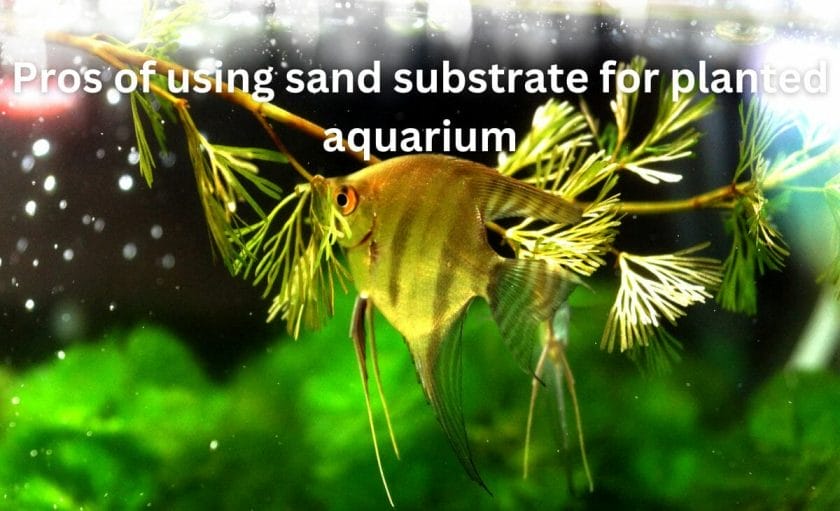
Sand is a natural substrate
Many live aquarium plants grow in sand in their natural habitat.
So planting such live aquarium plants in sand in your aquarium is a great way to mimic their natural habitat.
Some fish prefer sand substrate
There are several species of fish that live naturally where there is sand substrate, and they spend much of their time sifting through sand foraging for food.
So keeping sand substrate for such species of fish is ideal.
Cons of using sand substate for planted aquarium

Sand lacks nutrients
The biggest problem with using the sand substrate for planted aquariums is that sand doesn’t hold any nutrients for live aquarium plants, which they need for proper growth and development.
To solve the issue, you can insert root tabs into the substrate, which will provide nutrients to the plants.
Sand substrate is very compact
Sand substrate is very dense and compact, which may not allow some live aquarium plants to form complex root structures in the substrate.
FAQ

Can I use play sand in an aquarium?
Yes, you can use play sand in your aquarium.
But it will take a lot of work to prepare it for the aquarium.
First of all, you have to remove any visible impurities and debris from the play sand.
Then you have to put it in a large container, stir it up with a wooden spoon, and then drain all the water.
You will have to repeat this process at least 10 times so that no impurities remain in the sand.
Then you have to put the wet sand in a baking tray and bake it for at least 20 minutes at about 200 degrees Fahrenheit.
You can also put the wet sand in a pan, cover it with some water, and then boil it for 20 minutes.
This is to remove any harmful microorganisms from the water that may be harmful to your fish.
And now you can use this sand in your aquarium.
How can I make my aquarium sand settle faster?
Honestly, you can’t do much to make the aquarium sand settle faster.
Sand is very light and it is going to take a few days to settle in your aquarium.
But there are some mistakes that can cause more time for the sand to settle in your aquarium.
Also, there are some precautions you can take so that the sand will settle in as little time as possible.
- Do not run the filter– when you add sand in your aquarium and run the filter it will clog your filter and it cannot break it. The filter also causes water agitation so when you keep the filter off it will help to settle the sand faster.
- Put the send carefully– Now, this is very obvious, but it is worth mentioning. When you put sand in your aquarium, which already has water in it, you should be very careful. You should add sand in your aquarium little by little with your hands.
Just take some sand in your hand, close it tightly, put your hands into the aquarium to the bottom, and then slowly release it.
- Do not move the aquarium– After putting the sand into the aquarium, do not move the aquarium because it will cause water agitation, and that can cause more time to settle the sand in your aquarium.
- Perform frequent water changes– Now, by performing water changes, you are not necessarily making the sand settle faster, but you are actually removing some sand that is floating around in your aquarium.
- Do not put anything in the aquarium– You should not put anything like plants, submersible filters, etc in your aquarium until the sand is completely settled in it. Because this can cause water agitation, which results in more time settling the sand in your aquarium.
How long does it take for sand to clear in aquarium?
Usually, it takes about seven days to settle the sand in your aquarium completely.
It really depends on how much sand you are putting in your aquarium and the type of sand i.e. very fine or normal sand, and also the elements in your aquarium like plants, filters, etc.
How do you clean fine sand in an aquarium?
There are two ways to clear clean fine sand in the aquarium.
- Use a tube– Just put a tube into your aquarium and hover it over your sand substrate. The suction will remove any debris sitting on the surface of the sand substrate.
- Use a siphon– Now this is a very obvious way and probably many of you may know it. While using a siphon for cleaning the fine sand in your aquarium you should be a little bit more careful because the sand can easily get sucked into the siphon.
So the trick is to not keep siphon for a long time into the substrate i.e. sand.
The following video will help you to understand it better.
Check out our recommended Vaccum Cleaner or Siphon
How often should you change aquarium sand?
You don’t really need to change your aquarium sand ever, as far as you are keeping it clean.
Can aquarium plants live in the sand?
Yes, water column feeder aquarium plants can live in a sand substrate.
It is also important to prepare your sand substrate before introducing plants into the aquarium. You can do so by adding some root tabs, which will help plants get their roots anchored in the sand.
As water column feeder aquarium plants get the required nutrients from the water column, they can easily survive in a sand substrate.
Also, you can provide them with nutrients by adding root tabs regularly if the plant gets its nutrients from its roots.
Can I use sand in the freshwater tank?
Definitely, you can use sand in your freshwater tank.
And actually, there are some benefits of using sand in your freshwater aquarium than other substrates.
For example
- Sand provides more surface area than gravel for the colonization of beneficial bacteria
- Some freshwater fish species come from environments where the substrate is sand. So when you keep sand as a substrate for these fish species, it will help to make them feel at home.
- There are some fish species that only breed when there is sand as a substrate. So, in this case, the sand will help in breeding the fish.
- Sand can be ideal for certain aquatic plants. And you can always provide the essential nutrients to the plants by adding some root tabs.
On the other hand, there are some drawbacks of using sand as a substrate as well; for example, it is a bit more difficult to clean than a gravel substrate.
Do aquarium plants grow better in sand or gravel?
Live aquarium plants can thrive in both sand or gravel substrates.
That being said, both sand and gravel substrates have their pros and cons.
So you should consider them when choosing any one of them for your planted aquarium.
Actually, I have written a detailed article on this topic, which you can check out here.
Can you grow carpet plants in sand?
Carpet plants can survive and grow in sand substates.
However, sand substrate is not ideal for growing carpet plants.
Can stem plants grow in sand?
Stem plants can grow in sand; however, sand substrate is not ideal for them.
The reason for that is that sand substrate is very dense, and stem plants usually have delicate roots, so they cannot form very complex root structures in the sand substrate.
Due to this, they may easily get uprooted and float in the aquarium.
Can aquarium plants survive in an aquarium without substrate?
There are several aquarium plants that don’t actually need any substrate to keep in an aquarium.
For example, there are a lot of floating aquarium plants that you can keep in your tank.
Besides, there are other live aquarium plants, such as Java moss, which you can attach to anything like any ornament in your tank and keep in your tank.
Can aquarium plants grow in sand substrate?
There are several aquarium plants that can grow in sand. However, there are a few problems when it comes to growing live aquarium plants in a sand substrate.
The first problem is that the sand doesn’t contain any nutrients that are needed for the proper growth and development of the plants.
And the solution to this problem is to use root tabs to provide nutrients to the plants.
Another problem is that the sand substrate is very dense, which doesn’t allow the plants, which have delicate roots, to form complex root structures in the substrate.
So you should try to avoid planting such plants in your sand substrate aquarium.
Do plants grow in sand in nature?
There are several live aquarium plants that grow in sand substrate in nature.
Now you may be asking, how do they get the nutrients from the sand in nature?
Basically, in nature, usually the sand is mixed with soil, from which the plants get nutrients and grow.
What kinds of plants are easier to grow in sand substrates?
Plants that don’t rely on their roots to absorb nutrients from the substrate. And instead absorb most of the nutrients that they need from their leaves are easier to grow in sand substrates just because of the fact that sand substrates don’t hold any nutrients.
How to fertilize aquarium sand?
The best way to fertilize aquarium sand is to insert root tabs into the sand substrate.
The roof tabs will release essential nutrients into the sand substrate, which your live aquarium plants can absorb.
Do you need to rinse the sand before putting it in the aquarium?
You do need to rinse the sand before putting it in your aquarium.
To rinse the sand, simply place it in a bucket, fill it with water, and replace the water several times until no muddy water remains.
Can hydrocotyle grow in sand?
Yes, hydrocotyle can grow in a sand substrate. Just make sure to fertilize the sand with root tabs to provide essential nutrients to the plants for their proper growth and development.
Does pennywort grow in sand?
Yes, pennywort can grow in a sand substrate.
Can Bucephalandra grow in sand?
Bucephalandra can grow in sand. To plant it in sand, just bury the roots of the plant into the substrate and make sure that the rhizome of the plant is above the substrate.
Can Christmas moss grow on sand?
Christmas moss will not get attached to sand and grow on it. However, you can attach Christmas moss to any ornament, like driftwood or rock, and put it on the sand substrate.
How deep should aquarium sand be?
Your sand substrate should be around 2 inches deep.
If your sand substrate is more than 3 inches deep, then it is likely that anaerobic gas pockets will form in your substrate.
So again, you should keep your sand substrate 1-2 inches deep.
Can Ludwigia grow in sand?
Ludwigia can grow in sand. As it is a stem plant, it absorbs a lot of nutrients through its roots, so to make sure that the plant is getting all the nutrients that it needs for its proper growth and development, you should insert root tabs into the sand substrate.
Will Java moss attach to sand?
Java moss will not get attached to send. However, if you want to keep it in your sand aquarium, you can attach it to something like driftwood or rock and place it on the sand substrate.
Can I grow anubias in sand?
You can grow anubias in a sand substrate. However, just be careful while planting anubias in your sand substrate. While planting, you should just bury the roots of the plant into the sand substrate and keep the rhizome of the plant above the substrate.
This is important because if you bury the rhizome of the plant into the substrate, then the plant will rot.
Can micro sword (lilaeopsis brasiliensis) grow in sand?
Micro sword can grow in sand. However, to provide all the nutrients that plants need, you will need to fertilize the sand with root tabs.
Can Amazon sword grow in sand?
Amazon sword can grow in sand. However, Amazon Sword absorbs a lot of nutrients through the substrate, and if you are using a normal sand substrate, then it doesn’t hold any nutrients. So you will need to insert root tabs into the substrate to provide nutrients to the Amazon sword.
Conclusion
So these are the best plants that will do fine in a sand substrate.
I hope you found this article helpful.
Let me know which plant you are going to plant in your sand substrate.
Also, let me know if you have any other suggestions.
If you like the post please share it
Happy fishkeeping!










